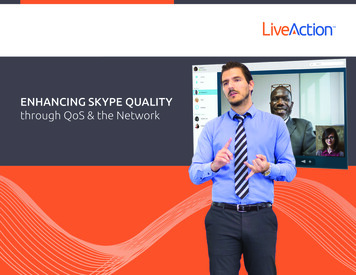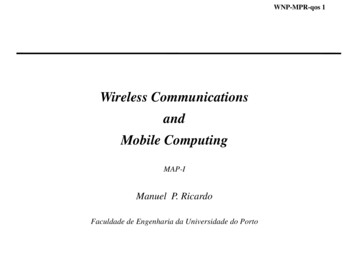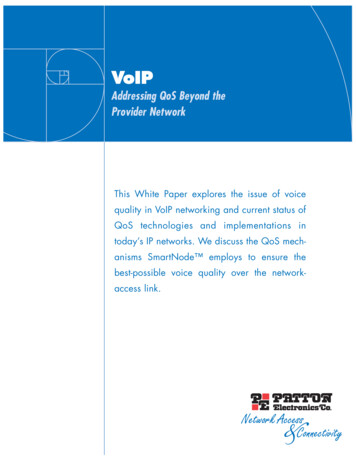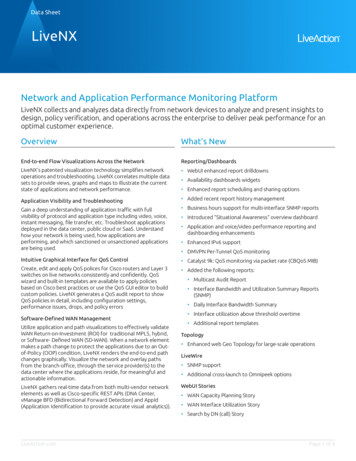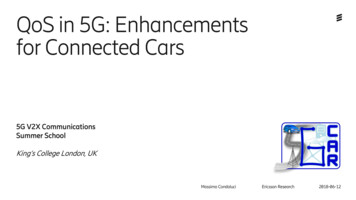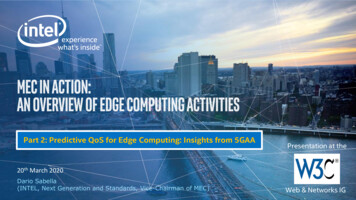
Transcription
Part 2: Predictive QoS for Edge Computing: Insights from 5GAAPresentation at the20th March 2020Dario Sabella(INTEL, Next Generation and Standards, Vice-Chairman of MEC)Web & Networks IG
AgendaIntro on edge computing (https://www.w3.org/wiki/Networks)MEC V2X API and Predictive QoS Use cases of interest 5GAA Predictive QoS MEC demoConclusionsAbstractPart )2Already presented in a past W3C conf callSlides here: 020Jan/att-0001/01-partETSI MEC standard Part 1Munich, 15-01-2020 – Presentation to W3C – Web & Networks IGThe talk will be focused on Intel activities on edgecomputing, ranging from standardization (e.g. ETSI MEC),industry groups (e.g. 5GAA – 5G Automotive Association)and mentioning also some PoCs and experimental activities.Particular focus will be given to MEC use cases of potentialinterest for W3C (e.g. application offloading), and on Intelengagement in the automotive domain (mentioning a recent5GAA Demo on MEC and predictive QoS).
5GAA(5G Automotive Association)
Driving Connected Mobility Forward5GAA brings together automotive, technology and telecommunications companiesto work closely together to develop end-to-end connectivity solutionsfor future mobility and transportation servicesAUTOMOTIVE INDUSTRYTELECOMMUNICATIONSVehicle Platform, Hardwareand Software SolutionsConnectivity and NetworkingSystems, Devices and Technologies5GAA unites today over 130 members from around the world working together onall aspects of C-V2X including technology, standards, spectrum, policy, regulations,testing, business models and go-to-marketMunich, 15-01-2020 – Presentation to W3C – Web & Networks IG4
5GAA Organisational StructureBOARDGENERAL ASSEMBLYEXECUTIVE COMMITTEEWG1WG2WG3WG4WG5WG6WG7Use Cases andTechnicalRequirementsSystemArchitecture andSolutionDevelopmentEvaluation,Testbeds and PilotsStandards andSpectrumBusiness Modelsand Go-To-MarketStrategiesRegulatory andPublic AffairsSecurity andPrivacyMunich, 15-01-2020 – Presentation to W3C – Web & Networks IG
What is C-V2X (Cellular-Vehicle to Everything)?A comprehensive road safety and traffic efficiencysolution that allows vehicles to communicate with:Mobile networks (V2N)Road Infrastructure (V2I)Cyclists via smartphones (V2P)Pedestrians viasmartphones (V2P)Other vehicles (V2V)Munich, 15-01-2020 – Presentation to W3C – Web & Networks IG
Supporting innovation:Leverage solutions together On-going dialogue between 5GAA and leadingtechnology partner organisations to advanceinnovation in all world regions 5GAA to continue strengthen technicalcooperation and maximise benefits with existingorganisations or projects by reinforcingengagement via common members Develop new partnerships with relevantorganisations on specific aspects e.g. vulnerableroad users or road authorities7
Automated and Connected cars – key driversConnected Car Vision Cloud V2X servicesOver the air updatesInfotainment / media deliveryIntelligent route and path planningTracking / fleet managementTransportation as a serviceMEC is a key technologyfor many of these driversInter-Car Communication Cars talk to another cars, pedestrians, road sideunits Road safety Telematics information exchange Environment perception Cooperative & automated drivingSuggested reading: 5GAA White Paper on Edge 2/5GAA T-170219-whitepaper-EdgeComputing 5GAA.pdfMunich, 15-01-2020 – Presentation to W3C – Web & Networks IG8
Predictive QoS in 5GAA 5G Automotive Association (5GAA) has developed the concept of predictive Quality of Service (QoS), which is a mechanismenabling mobile networks to provide advance notifications about predicted QoS changes to interested consumers. This makes it possible to adjust application behaviour before the predicted QoS change takes effect, which is important tocertain automotive use cases, such as remote and autonomous driving. QoS predictions may also be exposed to the V2X Application through a MEC service APIUse CaseTele-Operated DrivingQoS KPIs to be PredictedData rate, Latency, ReliabilityHigh-Density PlatooningLatency, ReliabilityHazardous Location WarningReliabilityLane MergeLatency, ReliabilityExamples of Potential Application ReactionsChange route, Park vehicle, Handover to nearbydriver, Change sensor set/properties, Changeteleoperation mode (e.g., from manoeuvring totrajectory provision)Change inter-vehicle distance, Handover to driver,Change platoon speed or length, Terminate platoonInform user about availability of warning service,Change speed, Change routeChange speed of merging attempt, Abort lane mergeSoftware UpdateInfotainmentData rateData rateReschedule, Stop or resume downloadChange video quality Work Item MEC 030 introducesnew MEC Service, called V2XInformation Service (VIS). Key requirement for MEC V2X APIis the support for service exposureand communication ability acrossparticipating V2X applications indifferent MEC systems Stable draft available at the MECOpen Area:https://docbox.etsi.org/ISG/MEC/OpenSuggested reading: 5GAA White Paper on “Making 5G Proactive and Predictive for the Automotive 0/01/5GAA White-Paper Proactive-and-Predictive v04 8-Jan.-2020-003.pdf9Munich, 15-01-2020 – Presentation to W3C – Web & Networks IG
5GAAIntel Demo on x-as-a-market-reality/
In-Vehicle Entertainmentutilizing Multi-AccessEdge Computing (MEC)over 5G Networks Multi-Access Edge Computing (MEC)is a key technology offering cloud computingcapabilities and an IT service environment atthe edge of 5G mobile networks. This demo, realized by Intel, together with Marelli,Terranet and Equinix, shows how MEC can supportimmersive high-definition (HD) entertainment for alloccupants of a moving vehicle, including videostreaming, gaming, virtual reality (VR), office work,online education, advertisement, etc.[figure: Continental AG]11
In-Vehicle Entertainment – motivation in 5GAAAutomotive sector is key for MEC and for 5G.These technologies will open the door to multiple use cases andservices that can be monetized by 5GAA stakeholders.In addition to traditional use cases on connected andautomated cars, infotainment is also a promising market.(Excerpt from Intel 5G Connected Vehicles Webinar):"Intel predicts a new 7 trillion passenger economy will emergewhen passengers become riders." [ ]"We did a study that shows drivers spend 300 hours a year behindthe wheel and 5G offers entertainment opportunities to optimizethat time as we transition from drivers to riders."[figure: Intel]12
Predictive QoS – reference scenariovehicle planning to follow a trajectoryfrom location A to location B ABExample of map @ Device/car DisplayMunich, 15-01-2020 – Presentation to W3C – Web & Networks IG
Predictive QoS – reference scenariopredicted QoS info examples:1 - Resource Type (GBR, delaycritical GBR or Non-GBR);2 - Priority level;3 - Packet Delay Budget;4 - Packet Error Rate.5 - Averaging window.vehicle planning to follow a trajectoryfrom location A to location BMEC could be used to support infodelivery of radio conditions “en route”,ahead of the vehicle’s passing time,before reaching a decision. ITSclientappAP (x,y,t)Edge CloudRAN/RSUITSMECappMunich, 15-01-2020 – Presentation to W3C – Web & Networks IGB
Predictive QoS – reference scenariovehicle planning to follow a trajectoryfrom location A to location BMEC could be used to support infodelivery of radio conditions “en route”,ahead of the vehicle’s passing time,before reaching a decision.Decisions may consist in e.g.,downloading infotainment content,enabling/disabling autonomous drivingfeatures, scheduling SW updates, etc. ITSclientappAP (x,y,t)Edge CloudRAN/RSUMunich, 15-01-2020 – Presentation to W3C – Web & Networks IGVideostream/ contentsB
Predictive QoS – reference scenariovehicle planning to follow a trajectoryfrom location A to location BMEC could be used to support infodelivery of radio conditions “en route”,ahead of the vehicle’s passing time,before reaching a decision.Decisions may consist in e.g.,downloading infotainment content,enabling/disabling autonomous drivingfeatures, scheduling SW updates, etc. ABUse Case 1 “coverage”Use Case 2 “coverage”Use case 3 “coverage”Munich, 15-01-2020 – Presentation to W3C – Web & Networks IG
In-Vehicle Entertainment – demosThis demo (based on IVE use case) aims at demonstrating two main concepts:MECApp The benefits of edge computing, bycomparing different deployment optionsRemoteAppUEAppwwwRemote AppserverRAN Edge CloudMECAppRemoteAppUEAppwwwVideo stream/ contentsRAN Edge Cloud[Realized by Marelli/Intel/Equinix] The multimedia delivery adaptation,thanks to Predictive QoS through realtimesimulation and live data from drive testsClient AppRemote AppserverMEC ServerSimuLTE/5G NetworkPGWUugNBXMedia Server[Realized by Terranet/Intel/UniPisa]17
In-Vehicle Entertainment – demosThis demo (based on IVE use case) aims at demonstrating two main concepts:MECApp The benefits of edge computing, bycomparing different deployment optionsUEAppRemote AppserverRAN Edge CloudMECAppUEApp[Realized by o stream/ contentsRAN Edge CloudRemote Appserver The multimedia delivery adaptation,thanks to Predictive QoS through realtimesimulation and live data from drive tests[Realized by Terranet/Intel/UniPisa]18
Benefits of Edge DeploymentsMECAppUEAppRemoteAppwwwRemote AppserverRAN Edge CloudMECAppUEAppRwwwVideo stream/ contentsRAN Edge CloudRemote Aserver The IVE client App running on the On-Board Unit (OBU) displays high-definition video contents to passengers basedboth on their interests and car context (e.g. position, heading, speed, etc.). Video contents are retrieved from off-board services in the Cloud or at the Edge. The demo shows how a media server instantiated at the edge can provide lower communication latencies, fasterservice response times, higher bandwidth and more dynamic and fine-grained geographical provisioning.19
Reference Architecture used for IVE App TestsOn-boardIVE MECOff-board ServiceCellularConnectivityOn-Board Unit (OBU)Edge Node (MEC) Runtime(*)IVE MECOn-Board AppMEC Edge Node (off-board)Frankfurt NodeDemoUser InterfaceIVE MECOff-board ServiceTablet or Digital CockpitPublic CloudAmsterdam NodeBenchmark NodesIVE MECOff-board ServicePublic CloudUSA Node(*) the usage of OpenNESS in the 5G live network is foreseen for a next phase of the trial activities21
MEC performance evaluation – preliminary comparative resultsDrive tests in Turin with 3 serverlocations: FrankfurtAmsterdamUSA23
In-Vehicle Entertainment – demosThis demo (based on IVE use case) aims at demonstrating two main concepts: The benefits of edge computing, bycomparing different deployment options[Realized by Marelli/Intel/Equinix] The multimedia delivery adaptation,thanks to Predictive QoS through realtimesimulation and live data from drive testsClient AppMEC ServerSimuLTE/5G NetworkPGWUugNBXMedia Server[Realized by Terranet/Intel/UniPisa]24
Collecting Data from Live Measurements in Turin Cellular network quality LOG file wascaptured during drive test in Turinwith Terranet softwareLOGfile Terranet provided client application,media server backend and cellularnetwork visualizationSimuLTE/5G NetworkPGWXUu Realtime emulation recreates networkquality from actual test drivegNB25
Test Drive Routes in TurinPath ofthe demoTurinSmart RoadcircuitSmart Road circuit26
Predictive QoS - Demonstration DiagramTerranet AppIntel MEC ServerSimuLTE/5G NetworkPGWUuXgNBTerranet SWLOG fileFrom drive tests Realtime 5G emulated environment connected with commercial terminal and a MEC server. The availability of information about Predictive Quality of Service (QoS) can be delivered by MEC to better supportimmersive high-definition (HD) entertainment for all occupants of a moving vehicle, including video streaming, gaming,virtual reality (VR), office work, online education, advertisement, etc. The benefits for passengers will be sustained high quality entertainment over 5G networks utilizing predictive QoS and MEC.NOTE: this simplified demo sets the stage for the next phase where the 5G network will beequipped with a MEC server on Intel Xeon SP server using Intel's OpenNESS software.27
Predictive-QoS impact on performance – preliminary resultsTest repeated in 2 conditions: Predictive-QoS activatedPredictive-QoS deactivatedP-QoSinfoMedia ServerPGWUuXgNBSimuLTE/5G Network28
Conclusions
Conclusions Edge computing is commonly recognized as an important technology for 5G tionalstandardforEdgeComputing(more recently also 3GPP started a work on edge computing for supporting 5G communication networks). ,WiFi,fixednetworks, )and also covering many verticals like automotive, as well as other industrial use cases.– Example below: synergy between standards and 5GAA (5G Automotive Association)Examples of industry groupsrelevant for ETSI MEC:Edge Computing standardizationCollecting inputs from 5GAA (andother Fora on automotive) inalignment with ETSI ITS 5G standardizationIndustry Groupon Automotive(not an SDO) 5G-ACIA (Alliance for Connected Industries andAutomation )5GAA (5G Automotive Association)INTEL is boardAECC (Automotive Edge Computingmember in 5GAAConsortium)and 5G-ACIA,also in VR-IF andVR-IF (Virtual Reality Industry Forum)present in manyOFC (Open Fog Consortium)other industrySCF (Small Cell Forum)groupsGSMA (MEC working group)BBF (BroadBand Forum)Ref [5]: an Intel-driven 5GAA White Paper on Edge Computing http://5gaa.org/wp-content/uploads/2017/12/5GAA T-170219-whitepaper-EdgeComputing 5GAA.pdf30Munich, 15-01-2020 – Presentation to W3C – Web & Networks IG
Thank you!dario.sabella@intel.com
References[1]ETSI White Paper: “Mobile Edge Computing: A key technology towards 5G”, September 2015; pers/etsi wp11 mec a key technology towards 5g.pdf[2]3GPP TS 23.501: System Architecture for the 5G System, June 2018, http://www.3gpp.org/ftp/Specs/archive/23 series/23.501/23501-f20.zip[3]5GPPP, “5G Vision: The 5G Infrastructure Public Private Partnership: The Next Generation of Communication Net-works and Services”, 2015. ion-Brochure-v1.pdf[4]ETSI GS MEC 003 V1.1.1 (2016-03) Mobile Edge Computing (MEC); Framework and Reference Architecture http://www.etsi.org/deliver/etsi gs/MEC/001 099/003/01.01.01 60/gs MEC003v010101p.pdf[5]5GAA white paper: “Toward fully connected vehicles: Edge computing for advanced automotive Communications”, Dec. 2017, http://5gaa.org/wpcontent/uploads/2017/12/5GAA T-170219-whitepaper-EdgeComputing 5GAA.pdf[6]5G-ACIA White Paper: “5G for Connected Industries and Automation”, April 2018, ted-industries-andautomation-white-paper/[7]ETSI MEC presentation at 5G-ACIA meeting, Frankfurt, October 2018[8]ETSI White Paper: “MEC in an Enterprise Setting: A Solution Outline”, September 2018, pers/etsi wp30 MEC Enterprise FINAL.pdf[9]ETSI press release on first MEC hackathons, October 2018, ng-solutions[10]Emara, Filippou, Sabella: “MEC-assisted End-to-End Latency Evaluations for C-V2X Communications”, EUCNC 2018, https://arxiv.org/pdf/1802.08027.pdf
MEC specs[MEC001]ETSI GS MEC 001 V1.1.1 (2016-03) Mobile Edge Computing (MEC) Terminology - http://www.etsi.org/deliver/etsi gs/MEC/001 099/001/01.01.01 60/gs MEC001v010101p.pdf[MEC002]ETSI GS MEC 002 V1.1.1 (2016-03) Mobile Edge Computing (MEC); Technical Requirements - http://www.etsi.org/deliver/etsi gs/MEC/001 099/002/01.01.01 60/gs MEC002v010101p.pdf[MEC003]ETSI GS MEC 003 V1.1.1 (2016-03) Mobile Edge Computing (MEC); Framework and Reference Architecture http://www.etsi.org/deliver/etsi gs/MEC/001 099/003/01.01.01 60/gs MEC003v010101p.pdf[IEG004]ETSI GS MEC-IEG 004 V1.1.1 (2015-11) Mobile-Edge Computing (MEC); Service Scenarios - http://www.etsi.org/deliver/etsi gs/MEC-IEG/001 099/004/01.01.01 60/gs MECIEG004v010101p.pdf[IEG005]ETSI GS MEC-IEG 005 V1.1.1 (2015-08) Mobile-Edge Computing (MEC); Proof of Concept Framework - http://www.etsi.org/deliver/etsi gs/MEC-IEG/001 099/005/01.01.01 60/gs MECIEG005v010101p.pdf[IEG006]ETSI GS MEC-IEG 006 V1.1.1 (2017-01) Mobile Edge Computing; Market Acceleration; MEC Metrics Best Practice and Guidelines - http://www.etsi.org/deliver/etsi gs/MECIEG/001 099/006/01.01.01 60/gs MEC-IEG006v010101p.pdf[MEC009]ETSI MEC 009 “General principles for Mobile Edge Service APIs” - http://www.etsi.org/deliver/etsi gs/MEC/001 099/009/01.01.01 60/gs MEC009v010101p.pdf[MEC010-1]ETSI MEC 010-1 V1.1.1 (2017-10) “Mobile Edge Management; Part 1: System, host and platform management” http://www.etsi.org/deliver/etsi gs/MEC/001 099/01002/01.01.01 60/gs MEC01002v010101p.pdf[MEC010-2]ETSI MEC 010-2 V1.1.1 (2017-07) “Mobile Edge Management; Part 2: Application lifecycle, rules and requirements management” http://www.etsi.org/deliver/etsi gs/MEC/001 099/01002/01.01.01 60/gs MEC01002v010101p.pdf[MEC011]ETSI MEC 011 V1.1.1 (2017-07) “Mobile Edge Platform Application Enablement” - http://www.etsi.org/deliver/etsi gs/MEC/001 099/011/01.01.01 60/gs MEC011v010101p.pdf[MEC012]ETSI MEC 012 “Radio Network Information API” - http://www.etsi.org/deliver/etsi gs/MEC/001 099/012/01.01.01 60/gs MEC012v010101p.pdf[MEC013]ETSI MEC 013 “Location API” - http://www.etsi.org/deliver/etsi gs/MEC/001 099/013/01.01.01 60/gs MEC013v010101p.pdf[MEC014]ETSI MEC 014 “EU identity API” - http://www.etsi.org/deliver/etsi gs/MEC/001 099/013/01.01.01 60/gs MEC013v010101p.pdf[MEC015]ETSI MEC 015 “Bandwidth management API” – http://www.etsi.org/deliver/etsi gs/MEC/001 099/015/01.01.01 60/gs MEC015v010101p.pdf[MEC016]ETSI MEC 016 “UE application interface” – http://www.etsi.org/deliver/etsi gs/MEC/001 099/016/01.01.01 60/gs MEC016v010101p.pdf[MEC018]ETSI MEC 018 “End to End Mobility Aspects” - http://www.etsi.org/deliver/etsi gr/MEC/001 099/018/01.01.01 60/gr MEC018v010101p.pdf33
Intel Notices and DisclaimersIntel provides these materials as-is, with no express or implied warranties.All products, dates, and figures specified are preliminary, based on current expectations, and are subject to change without notice.Intel, processors, chipsets, and desktop boards may contain design defects or errors known as errata, which may cause the product todeviate from published specifications. Current characterized errata are available on request.Intel technologies' features and benefits depend on system configuration and may require enabled hardware, software or serviceactivation. Performance varies depending on system configuration. No product or component can be absolutely secure.Check with your system manufacturer or retailer or learn more at http://intel.com.Some results have been estimated or simulated using internal Intel analysis or architecture simulation or modeling, and provided toyou for informational purposes. Any differences in your system hardware, software or configuration may affect your actualperformance.Intel and the Intel logo are trademarks of Intel Corporation in the United States and other countries.*Other names and brands may be claimed as the property of others. Intel Corporation34
thanks to Predictive QoS through realtime simulation and live data from drive tests [Realized by Marelli/Intel/Equinix] [Realized by Terranet/Intel/UniPisa] 19 Benefits of Edge Deployments The IVE client App running on the On-Board Unit (OBU) displays high-definition video contents to passengers based
